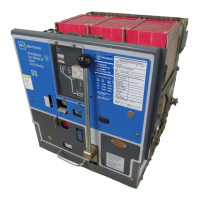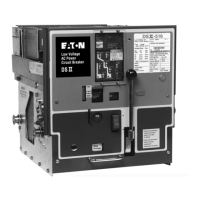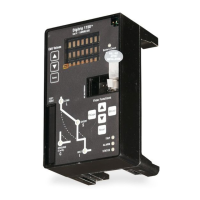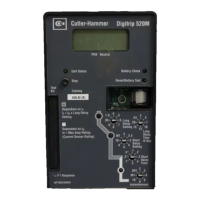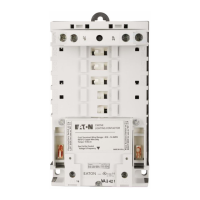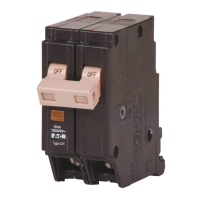1.8. 33-790-11
5.1.7.4 The CONNECT Position
This is the position
in
which both primary and secondary
disconnecting contacts on the breaker are engaged with
their stationary counterparts
in
the compartment.
It is the farthest position from the front
of
the compart-
ment into which the breaker can be levered, as (1) shown
by
the drawout position indicator, and (2) when the
mechanical stop is felt as a sudden increase
in
load on
the levering crank handle.
Note: When levering
in
from the TEST position, an
increase
in
load on the crank handle will be felt as
the main disconnecting contacts are engaged. As
cranking
is
continued, the load will decrease some
and then suddenly increase as the final connected
position stop
is
reached.
In
this position all
of
the conditions listed for TEST posi-
tion also exist, except
IN
THIS POSITION, DO NOT ATTEMPT TO ELECTRl-
CALL Y CHECK THE AMPTECTOR TRIP DEVICE
WITH THE TEST KIT
OR
BY ANOTHER METHOD
BECAUSE BREAKER WILL BE TRIPPED AND CAUSE
DISRUPTION OF SERVICE.
The trip plate
on
the hinged compartment door will be
operative, and can be used to trip the breaker when this
door is closed.
In
addition to the above interlocks, the interference inter-
lock described
in
Section 5.1.6.1 prevents a breaker
of
the wrong frame size from being placed
in
a compart-
ment.
5.1.8 Detailed Explanation
of
Mechanical Interlock
System
That part
of
the interlock system which prevents closing
of
the breaker while being driven
in
either direction
by
the
levering device,
or
while it is standing
in
any intermediate
position between ''TEST" and "CONNECT"
or
"DISCON-
NECT", is shown
in
Figure 28a and
b.
Figure 28a shows
the shutter and trip plate for normal operation, such as
in
DISCONNECT, TEST,
or
CONNECT positions. The
breaker can be closed and tripped open
by
all available
devices
in
the latter two positions except the trip plate
on
the hinged compartment door.
In
Figure 28a, the shutter prevents pushing the levering
device crank handle onto the worm shaft.
If
the shutter
alone is pushed downward, it will rotate slightly about its
pivot pin and its lower projection (See Figure 28a) strikes
Effective October 1998
Page
31
the hook
on
the trip plate, and the worm shaft will not be
cleared. So it is necessary to push the trip plate in, which
moves the hook back out
of
the way
of
the shutter lower
projection. This permits the shutter to be pushed down-
ward to clear the worm shaft for the levering device crank
handle, as shown
in
Figure 28b.
Note that pushing the trip plate
in
also pushes the trip
shaft pin so as to rotate the trip shaft counterclockwise,
thus tripping the breaker open.
If
closing is attempted
with the linkage as
in
Figure 28b, a trip free operation will
be made.
Movement
of
the shutter also is controlled by the inter-
lock cam, mounted on the levering device shaft to the left
of
the worm gear. The interlock cam has a fixed relation
to the levering device arms. Figure 29a,
b,
c,
and d show
the relation between the shutter, interlock cam and lever-
ing device arms for the four basic positions
of
the dra-
wout unit
in
the compartment.
Figure 29a shows the CONNECT position. The cam is
in
a position to allow free travel
of
the shutter interlock pin.
Therefore the shutter can be pushed downward, but only
after pushing
in
the trip plate as
in
Figure 28. This trips
the breaker and therefore prevents levering out with the
breaker closed.
Figure 29b shows the TEST position. Note that between
CONNECT and TEST positions the cam will rotate so as
to block the shutter interlock pin. This prevents the shut-
ter returning to its closed position and releasing the trip
plate if the levering device crank handle is removed.
Thus, if a closing operation is tried during this part
of
the
travel, a trip-free operation occurs and the breaker con-
tacts do not close. Note that this is true for either direction
of
breaker travel so that no load is made
or
broken at the
disconnecting contacts.
When the breaker gets to the TEST position, a slot
in
the
interlock cam allows free movement
of
the shutter inter-
lock pin, and the shutter returns to closed position when
the crank is removed. The levering device arms are
almost vertically downward.
Figure 29c shows the DISCONNECT position. Here also
the cam rotates so as to block the shutter interlock pin
while the breaker is between positions thus holding the
shutter open. When the exact position, as shown on the
indicator, is reached, the shutter will close when the
crank is removed. The levering arms will be approxi-
mately 40° below the horizontal.
Courtesy of NationalSwitchgear.com

